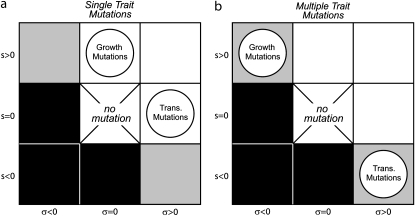Figure 2.—
Schematic of the mutation process. The possible mutations naturally partition into eight regions, depending on the relative signs of s and σ (s = 0 and σ = 0, which do not affect fitness, are not considered). Solid regions contain deleterious mutations, while mutations in open regions are always beneficial. Shaded regions, in which mutations are positive for one variable and negative for the other, may be either beneficial or deleterious. For each version of the model discussed, two types of mutation (“growth” or “transmission”) can occur, and the regions in which they exist are denoted by the circles. (a) Allowed mutations when pleiotropy is not present. Growth mutations increase growth, g, by s, while transmission mutations decrease death, d, by σ. (b) Allowed mutations with negative pleiotropic effects. Beneficial growth mutations lead to a decrease in d (σ < 0) while beneficial transmission mutations lead to a decrease in g (s < 0).

